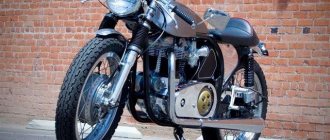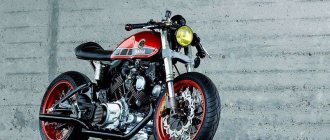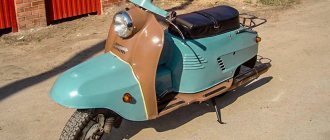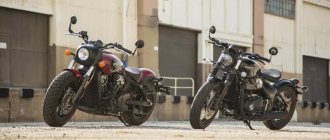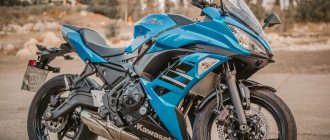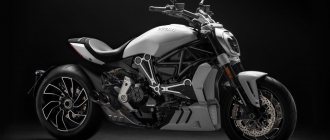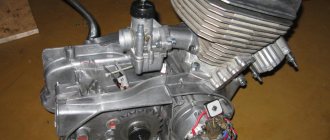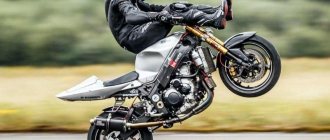All about motorcycles
The Bobber is a unique motorcycle concept that involves removing or making the rear and front fender as light as possible.
The motorcycle industry is developing very unevenly, therefore, unlike the trends in Western countries, in the vast expanses of the former USSR this fashion has taken root only recently .
This technology is very expensive, however, if you have the necessary skills and available materials, you yourself can “tune” the iron horse.
Motorcycle "Bobber"
Returning to the main difference between this type of motorcycle, it is worth immediately clarifying which parts need to be replaced most often: seats, headlights, battery and gas tank.
All of the listed elements are replaced with lighter analogues .
They are not removed for obvious reasons: without these elements, the motorcycle will simply be unsuitable for safe (or at least any) riding.
The essence of tuning is to reduce weight without changing technical and driving characteristics.
You can also permanently remove such parts from the motorcycle as: the windshield, the horn, the protective racks of the motorcycle, the entire front fender, the rear suspension, the front wheel brakes, the muffler, as well as the speedometer and tachometer.
Also, from time to time , motorcycle fasteners that do not have a “global” meaning are removed .
The history of Bobber goes back to the distant “rockabilly” 30-40s of the last century. At that time, the first motorcycle clubs were founded in America, and accordingly, the bike subculture was developing with all its might.
Motorcycle clubs tried to keep up with competitors and send their representatives to races, which were gaining more and more popularity.
The main problem for the competitors was the technical capabilities of the motorcycle . At the time of the 30s, Harley-Davidson was widespread, and its models were distinguished by their enormous weight and disproportionately weak engine.
It was necessary to modernize the motorcycles to suit the conditions of racing on dirt roads. The wings were removed so that the ground would not get clogged under them, and the design was changed in every possible way to reduce weight.
Due to the unstable economy, Bobber Style motorcycles were not just racing motorcycles. They had to ensure safe driving everywhere, both on competition tracks and on city roads.
The main idea is based in three parts:
- First and foremost, a motorcycle is just a means of transportation;
- The motorcycle must be designed to overcome dirt tracks;
- The bike should be simplified as much as possible, everything that is mediocre should be removed from it, but the riding ability should remain intact.
Recognizable appearance
The first thing we can say is that the style is still based on classics. They don't build motorcycles like this from superbikes, that's all. In general, a bobber is a motorcycle, photos of which inevitably cause delight even among those who are very far from bike culture. And the approach of the rumbling, sparkling apparatus unbearably resonates in the soul with the desire to ride at least on the back saddle. So, the distinctive features of the style: lightweight design, chrome, leather, a bunch of designer features. Often, but not always, a bobber does not have a front fender. This is a tribute to the style and memory of the founders. After all, in those days, asphalt roads were rare in the States, and long races on dirt roads would cause dirt to accumulate under the fender. Often, the design of a bobber does not provide for the presence of a rear saddle, and this reflects not only respect for the original sources, but also the conviction that a real biker is always a lone wolf.
Bobber Style Evolution
Over time, the Bobber style has varied in both quantity and quality .
In parallel with the changes in motorcycles, hot-rodding cars also developed. In history there are often intersections between them.
Unlike choppers, the classic bobber was an absolutely sporting attribute .
They were used to study the area, and they were often used for difficult and long journeys, often associated with risk.
The main features of this classic design are: a dense and strict silhouette that excludes anything unnecessary, a low, even steering wheel, a low-neck frame with a short “fork,” as well as wide and stable wheels that allow you to feel more confident in the “saddle.”
After the 50-60s, the model slightly changed its appearance: the frame became higher, the fork angle changed more than once, the steering wheel became wider, and the wheels were almost completely equal in size.
In the 50s, a landmark film for the style, “The Savage,” was released, which incorporated these standards into the classic image.
This turned out to be so successful that even after the appearance of good roads throughout the United States, bobbers were at the peak of their glory for decades.
In the 21st century, the need for such racing motorcycles has completely disappeared. Therefore, modern Bobber motorcycles have become only an external resemblance to the classics .
Nowadays they like to add pathos to this image, so a motorcycle can have an unexpectedly high fork, as well as a bulky disproportionate muffler .
The style was divided into two branches: “old school” and “new school”.
There are a number of modern motorcycles that are most often converted into bobbers:
- Ural;
- Kawasaki Vulkan;
- Harley-Davidson Sportster;
- Yamaha Dragstar;
- Honda Shadow.
CHOPPER – NO EXTRA ELEMENTS AND EXTENDED FRONT FORK
Pictured: Miss Behavin Green
The first such motorcycle appeared in 1948 in California. At first, choppers were made on the basis of the legendary production motorcycles Indian and Harley-Davidson. Now any production bike is suitable for a chopper. The name of the motorcycle comes from the English word “chop” - “to chop”. In the developers' interpretation: cut off all unnecessary parts from the finished production bike. Other road motorcycles are often called choppers. However, their characteristic feature, the hallmark of the style, is the elongated front fork and frame. Motorcycles are made as light as possible, their front forks are lengthened and, as a rule, they are equipped with a wide rear wheel and a “horned” steering wheel. This type of motorcycle is suitable for long-distance highway riding. Today there are 3 branches of style development: old school, production of show-stoppers (such bikes are more suitable for exhibitions than for riding) and modern custom school with various design variations.
DIY Bobber
For example, take the renowned Deep Creek Cycleworks, who created the perfect vintage concept based on a 1969 Guzzi V7 750 Special.
From the base, the craftsmen left the frame, engine, suspension with wheels, as well as other small parts.
In addition to the base, other elements were taken for work:
- "Dime City Cycles": tires, handlebars, various levers and switches, as well as lowered shock absorbers;
- seat;
- Small in size battery, technical parameters superior to the original one;
- Hull repainting and decoration.
No matter how logical it may sound, the driver should first of all think about safety , and not about appearance.
Shoes and pants should not allow moisture to pass through, and dust and dirt should also be easily wiped off.
The driver must also have a helmet on his head. It is recommended to wear turtle motorcycle protection.
Times change
Who would think of flying a bobber around a racing oval today? And why do this if the world's best motorcycle manufacturers invented the sportbike a long time ago and created many models designed for high speeds? Is it worth dragging a bobber into rough terrain and maneuvering it among young pine trees and rare marshy puddles? It’s unlikely, because enduro exists for these purposes. The long-range bobber will certainly survive, but can it compete on a long journey, for example, with the comfortable and durable “Goldwing”?
Today, a bobber motorcycle is, first of all, style, prestige, a tribute to the unforgettable past and an indicator of respect for the biker’s philosophy. One more detail is important - initially this bike was designed to bear traces of manual labor and soul investment. After all, the one who stood at the origins repaired, improved, built and remodeled the bobber motorcycle with his own hands. This bike has a custom soul. Seriality does not suit him. That’s why this style attracts those who are used to trusting their own head, imagination, skill and skillful hands. By the way, Soviet technology is used as a basis, for example, “Dnepr”. A bobber built from it looks no worse than a tuned “foreigner”.
Photo gallery
The presented selection will allow you to see the variety and individuality that Bobber style dictates to us. These motorcycles are built by master craftsmen using vintage components, so there's plenty of room to get creative.
Transformations
Modern bobbers are not used in racing at all. They perform one task - they carry the rider, whom they definitely pay attention to. However, the essence remains, confirming the name. From English it is translated as short-haired. Therefore, everything that does not match the style is mercilessly removed.
Among the Russian ones, the most suitable for transformations are the Ural motorcycles, and among the foreign ones - Harley-Davidson Sportster, Honda Shadow 400, Kawasaki Vulkan 900, Yamaha Dragstar 400. To become the owner of a bobber, it is not necessary to contact specialists who can perform tuning. Everything can be done with your own hands.
We'll have to replace the seat and install a tank of about 10 liters. If the battery is too bulky, it is also replaced with a lightweight one. You should take a closer look at the headlight - it should be small. This is the most difficult job.
There are elements that simply have to be removed: the wing and brakes at the front, the suspension at the rear, the muffler, the tachometer, the speedometer, the windshield, the horn. The final touch is making the drawings. This will emphasize individuality.
Main stages of the process
So, the first step is the concept, and with that everything is clear. However, it is approximate. The second stage will be accurate calculations in order to separate the desired from the possible, and understand where they still intersect.
This is perhaps the most difficult moment, since it is important to understand what can be removed and what cannot be removed under any circumstances. In order not to make a mistake, you need to have an increased level of literacy regarding motor vehicles.
Then, before starting work, it is important to make sure that all the necessary parts are available. If something is missing, you should first find it, order it, and only when you are completely sure that everything is there, start working.
You will need a spacious room where you can place all the necessary tools, including a welding inverter, a set of screwdrivers, and protective equipment. Even a small car garage is suitable, in which, however, there are no other vehicles except IZH Jupiter 5.
Finally, you can start working. Everything unnecessary is removed. A typical bobber seat with fairly large shock absorbers is installed. The rest can be left, but if desired, you can modify the steering wheel and change the wheel ratio. Finally, all that remains is to paint the bike so that it matches the original design.
